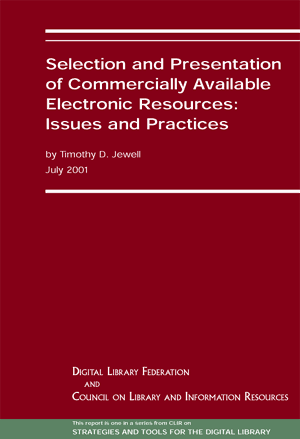
by Timothy D. Jewell
July 2001
Copyright 2001 by the Council on Library and Information Resources. No part of this publication may be reproduced or transcribed in any form without permission of the publisher. Requests for reproduction should be submitted to the Director of Communications at the Council on Library and Information Resources.
About the Author
- 1.1. Scope and Perspectives
- 1.2. Methodology, Aims, and Organization
- 2.1. The Economic Context of Electronic Resource Selection
- 2.1.1 Consortial Purchasing and Pricing
- 2.1.2. Scholarly Communication Reform Initiatives
2.2. Selection Policies and Strategic Plans
- 2.2.1. Selection Policies
- 2.2.2. Strategic Plans
2.3. Institutional Finance and Organization2.4. Internal Procedures for Initial Evaluation and Purchase2.5. Licensing Issues and Practices2.6. Web Presentation Strategies2.7. User Support2.8. Ongoing Evaluation and Usage Information2.9. Preservation and Archiving2.10. Toward Integrated Systems for Managing Electronic Resources
- Appendix A: Selection and Presentation Documents and Web Pages
- Appendix B: Functions and Data Elements for Managing Electronic Resources
Tables
- 1. DLF Member Libraries’ Consortial Memberships
- 2. Idealized Model of Effective Selection and Presentation Practices
About the Author
Tim Jewell became head of collection management services at the University of Washington in 1998. He has been involved in the coordination of electronic resources there since 1992, when he was appointed head of the UW Libraries’ Electronic Information Program. He has been active in regional consortium activities for several years and served as visiting program officer for electronic resources at the Association of Research Libraries from 1996 to 1998. He received a master’s degree in library science from SUNY-Albany, and a master’s degree in sociology from the Pennsylvania State University. He recently published an article on “Library Resources and Services for Sociology” in the second edition of the Encyclopedia of Sociology.
Acknowledgments
The author would like to thank the University of Washington Libraries and the Digital Library Federation for the opportunity to conduct the research for this report. Thanks are also due to several people who provided information about their local practices and who offered suggestions, feedback on earlier drafts of this report, encouragement, or other support. Special thanks go to Ivy Anderson, Ellen Duranceau, Sharon Farb, Beverlee French, Dan Greenstein, Bonnie MacEwan, Joyce Ogburn, Kim Parker, Louis Pitschmann, Rue Ramirez, Carole Richter, Diane Rosolowsky, Ronda Rowe, Tom Sanville, Abby Smith, and Paula Watson.
Preface
In January 2000, the Digital Library Federation (DLF) launched an informal survey to identify the major challenges confronting research libraries that use information technologies to fulfill their curatorial, scholarly, and cultural missions. With astonishing unanimity of opinion and clarity of voice, respondents pointed to digital collection development as their single greatest challenge. Whether the digital information came from a commercial publisher or from a digitization unit within the library, it seemed to exist under a cloud of profound and unsettling uncertainty. Would it be useful and useable in its present or intended form, or require additional work on the part of catalogers, systems staff, or subject bibliographers? What new demands would its availability make on library reference staff? What level of continued investment would be necessary to ensure its accessibility on current hardware and software?
The survey also revealed that leading research libraries had learned a great deal about their digital collections through experience. Though substantial, that learning had rarely been expressed outside the collection policies, working papers, and implementation guidelines that libraries create to coordinate and manage their collection development efforts. Accordingly, in April 2000, the DLF commissioned three reports to address broader concerns about digital collections. The three reports deal respectively with commercial electronic content, digital materials created from library holdings, and Web-based “gateways” that link to selected Internet resources in the public domain. The reports mark a starting point for what we hope will emerge as an evolving publication series.
Working to a common outline and based on learned experience, the authors demonstrate how decisions taken by a library when acquiring (or creating) electronic information influence how, at what cost, and by whom the information will be used, maintained, and supported. By assembling and reviewing current practice, the reports aim where possible to document effective practices. In most cases, they are able at least to articulate the strategic questions that libraries will want to address when planning their digital collections.
Tim Jewell looks in depth at how a number of leading research libraries select, license, present, and support the use of commercial online materials. Uncovering a variety of practices, he is careful to identify those that converge and illuminate the most effective means for integrating commercial online materials sustainably into library collections. Since the cost of commercial content is a major concern to both libraries and publishers, the report begins there. It critically assesses the licensing options that are available to libraries, individually and consortially, and some of the emerging strategies that libraries are using to contain costs. Subsequent sections deal with operational challenges and follow the commercial resource’s “life-cycle” from ordering and purchasing to cataloging, Web presentation, user support, use assessment, and preservation. The report concludes with a table that summarizes the most effective practices that are uncovered.
The author does not set out to provide a recipe for sustainability so much as a commentary on the important issues that libraries must address as they increase their investments in commercial online materials. In effect, he gives us a decision tool that emphasizes and supports strategic planning, and encourages careful consideration of how libraries’ functions and professional staff are organized. He also supplies an essential reference tool, citing working papers and operational guidelines that libraries rely on but rarely “publish.” Finally, he frames an important and practical development agenda by encouraging libraries to collaborate in designing information systems capable of organizing the detailed and often dynamic information they need to maintain about their commercial holdings.
Daniel Greenstein
Director, Digital Library Federation

